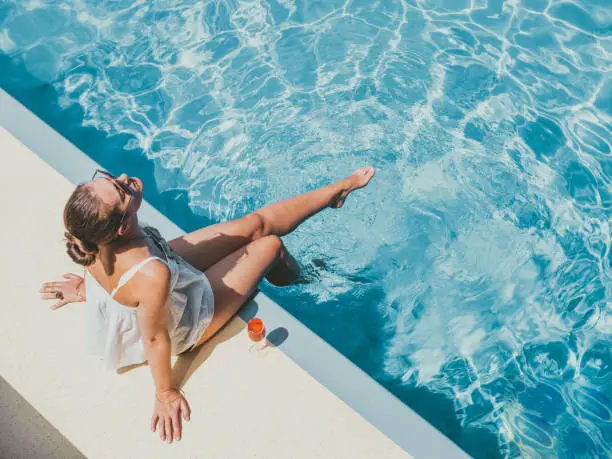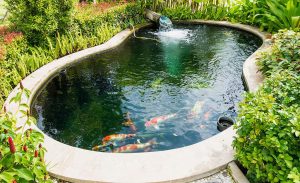As summer gets closer, there’ll be nothing quite like taking a refreshing dip in your backyard pool. But when the water temperature starts to feel more like a warm bath than a cool oasis, it can quickly put a damper on your swimming enjoyment. Whether you have an in-ground or above-ground pool, keeping the water at a comfortable temperature is key to maximizing your pool time fun.
Fortunately, there are a variety of strategies and solutions you can employ to keep your pool cool and inviting all summer long. From simple shade solutions to high-tech cooling systems, we’ve compiled the ultimate guide to help you beat the heat and create the perfect backyard retreat.
Before we explore the various cooling methods, it’s important to understand what factors influence your pool water temperature and what temperature range is considered ideal for swimming comfort.
Also read: How Much Does an Inflatable Hot Tub Weigh? – 4 Factors to consider
Factors Affecting Pool Temperature

Several key elements can cause your pool water to heat up, including:
- Sun exposure: Direct sunlight is the primary culprit behind rising pool temperatures. As the sun’s rays penetrate the water, they transfer heat energy, gradually warming up the pool.
- Air temperature: Hot air surrounding the pool can also contribute to water temperature increases, especially during heat waves or in particularly warm climates.
- Pool depth and volume: Shallower pools with less water volume tend to heat up faster than deeper pools, as there is less water to absorb and disperse the heat.
- Surrounding surfaces: Dark-colored or heat-absorbing surfaces around the pool, such as concrete or stone pavers, can radiate heat into the water.
Ideal Pool Temperature Range
The perfect pool temperature is somewhat subjective and can vary based on personal preference, swimming activity, and outside weather conditions. However, here are some general guidelines:
- Recreational swimming: 78-82°F (25-28°C) is considered comfortable for leisure swimming and playing.
- Exercise and lap swimming: A slightly cooler temperature of 75-78°F (24-26°C) is often preferred for more vigorous activity.
- Children and elderly: Young children and older adults may prefer warmer temperatures around 82-86°F (28-30°C) for added comfort.
Keep in mind that while a pool that’s too warm can feel uncomfortable and limit the refreshing benefits of swimming, a pool that’s too cold can also be shocking and discourage use. The key is finding the right balance for your needs and preferences.
Shade Solutions for Cooling Your Pool
One of the most effective ways to keep your pool cool is by blocking out the sun’s direct rays. Here are several shade solutions to consider:
1. Shade Sails
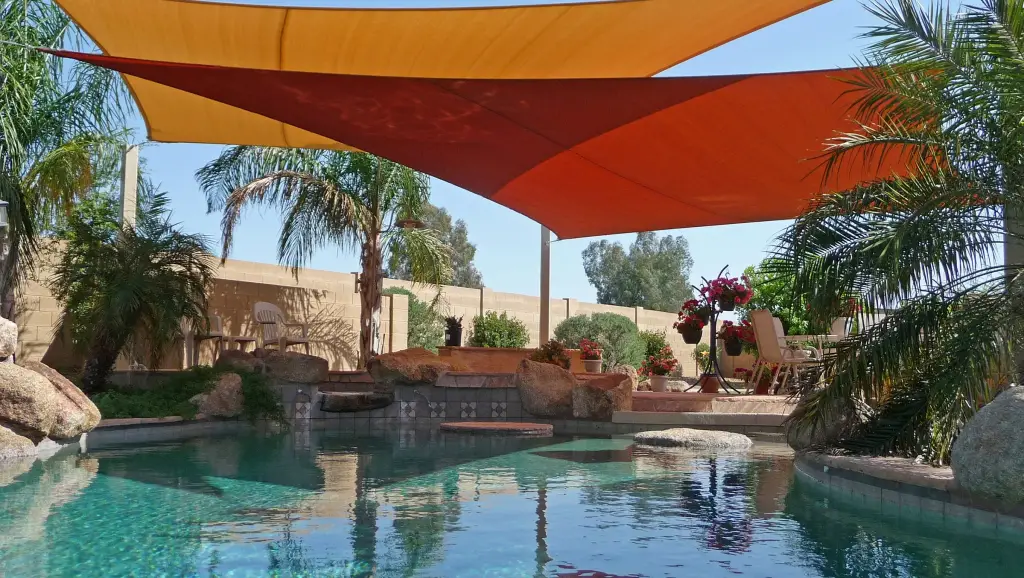
Shade sails are large, triangular, or rectangular pieces of fabric that are stretched and anchored between posts or trees to create a shaded area over your pool. They come in a variety of colors and sizes, allowing you to customize the look to match your backyard aesthetic.
Pros:
- Relatively affordable and easy to install
- Can be removed or adjusted as needed
- Provide ample shade coverage
- Add a modern, stylish element to your pool area
Cons:
- May not provide complete shade coverage depending on the angle of the sun
- Require sturdy anchor points and proper installation to withstand wind and weather
- Fabric may degrade over time due to sun exposure
2. Pergolas

A pergola is a permanent, open-aired structure featuring columns or posts that support a slatted or latticed roof. When positioned strategically near your pool, a pergola can provide dappled shade while still allowing some sunlight to filter through.
Pros:
- Offers a classic, elegant look that enhances your backyard design
- Can be customized with climbing plants for added shade and beauty
- Provides a defined space for outdoor living and entertaining
- Increases your home’s value as a permanent structure
Cons:
- More expensive and time-consuming to install than temporary shade solutions
- May require professional installation and permits
- Offers less flexibility in terms of shade positioning and coverage
3. Umbrellas and Cantilevers

Large, adjustable umbrellas or cantilever shades are a simple and portable way to provide targeted shade over specific areas of your pool or seating areas.
Pros:
- Highly affordable and easy to set up
- Can be moved or adjusted throughout the day to block the sun
- Offer flexibility in terms of placement and coverage
- Available in a wide range of styles, colors, and sizes
Cons:
- Provide limited shade coverage compared to larger structures
- May not withstand strong winds or severe weather
- Require proper weighting or anchoring for stability
4. Retractable Canopies

Retractable canopies are motorized or manual shade structures that can be extended or retracted as needed. They are typically mounted on a track system and can cover a significant portion of your pool area.
Pros:
- Offer flexibility to choose between shade and sun exposure
- Can be easily retracted during cooler periods or inclement weather
- Provide ample shade coverage when fully extended
- Can be customized to fit your pool size and shape
Cons:
- More expensive than other shade options due to mechanical components
- Require professional installation and electrical wiring for motorized models
- May not be suitable for extremely windy conditions
Cooling Systems and Technologies
In addition to shade solutions, there are several active cooling systems and technologies available to help regulate your pool water temperature:
1. Pool Chillers

Pool chillers are mechanical units that work similarly to air conditioners, using refrigerant to cool the water as it passes through the system. They are highly effective at maintaining a consistent, cool water temperature.
Pros:
- Provide precise temperature control and rapid cooling
- Work well in extremely hot climates or for pools with high sun exposure
- Can be used in conjunction with a pool heater for year-round temperature regulation
- Operate quietly and efficiently
Cons:
- Require professional installation and electrical hookup
- Have a higher upfront cost compared to other cooling methods
- May increase energy consumption and utility bills
Related: Best Central Air Conditioner Brands to Get in 2024
2. Reverse Cycle Heat Pumps
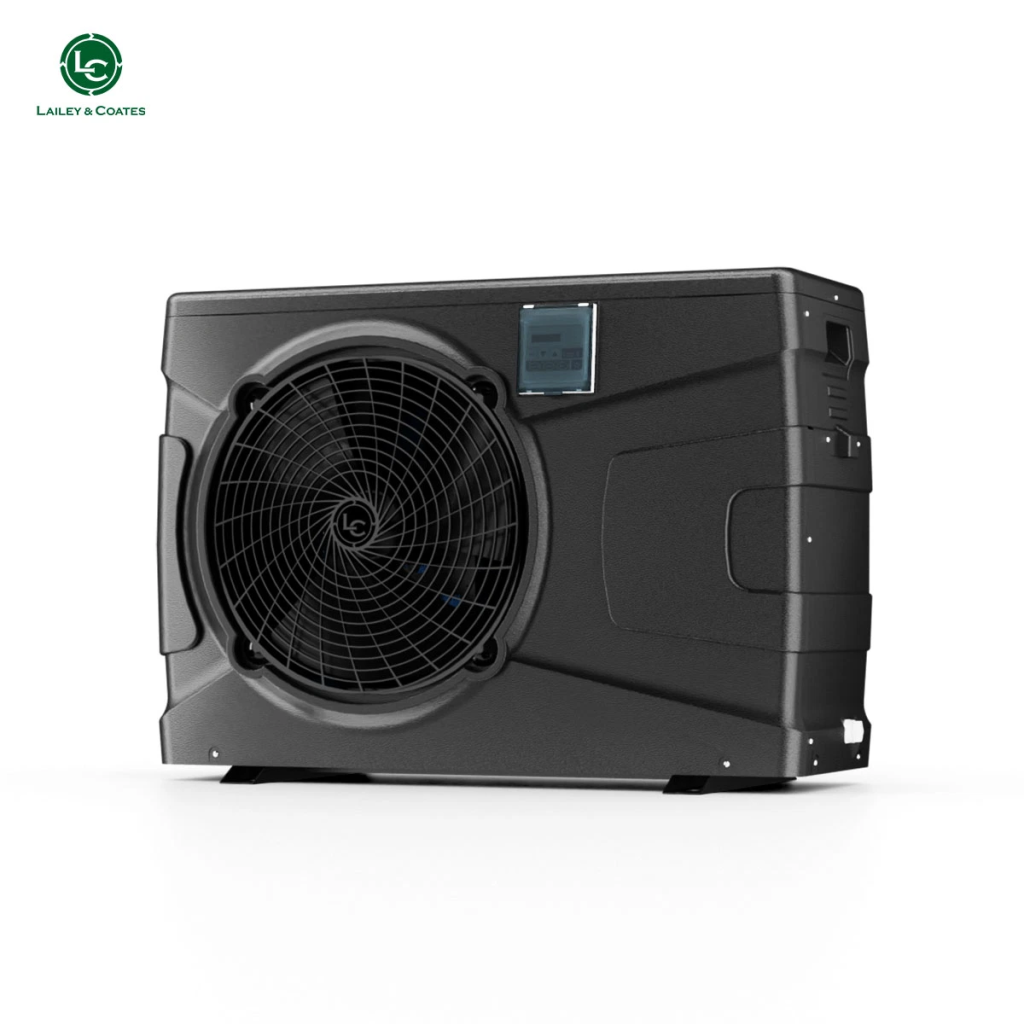
Reverse cycle heat pumps, also known as heat-cool pumps, are versatile units that can both heat and cool your pool water depending on the season. They work by extracting heat from the air and transferring it to the water (heating mode) or extracting heat from the water and releasing it into the air (cooling mode).
Pros:
- Provide both heating and cooling functions in one unit
- Operate more efficiently than traditional electric heaters
- Can maintain a consistent water temperature year-round
- Work well in moderate climates with occasional hot spells
Cons:
- Less effective at cooling in extremely high temperatures compared to chillers
- Require professional installation and electrical hookup
- May have a higher upfront cost than standalone heaters or coolers
3. Evaporative Coolers
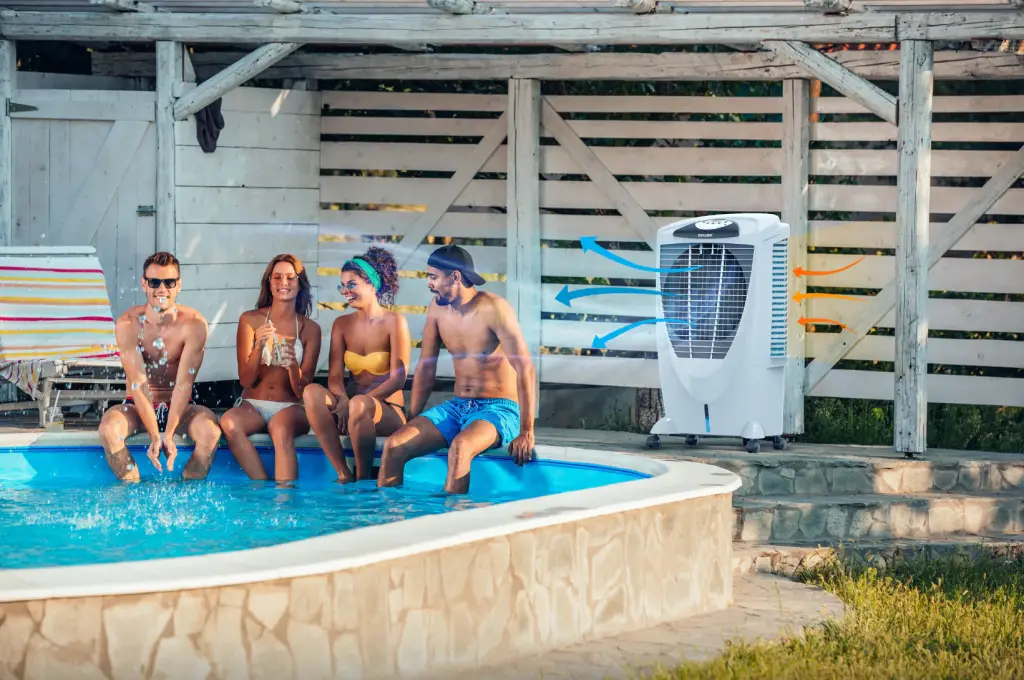
Evaporative coolers, also known as swamp coolers, work by passing warm pool water through a cooling pad or membrane that is moistened with cold water. As the warm water evaporates, it cools the remaining pool water before returning it to the pool.
Pros:
- More affordable and energy-efficient than mechanical chillers
- Easy to install and maintain
- Work well in dry, arid climates where evaporation rates are high
- Can be used in conjunction with a pool heater for temperature balance
Cons:
- Less effective in humid climates where evaporation rates are lower
- May require frequent pad or membrane replacements
- Can increase water consumption due to evaporation
Natural Cooling Techniques
In addition to shade structures and mechanical cooling systems, there are several natural techniques you can employ to help keep your pool cool and refreshing:
1. Strategic Landscaping

Planting trees, shrubs, or tall grasses around your pool can provide natural shade and help block the sun’s rays. Choose species that are well-suited to your climate and provide dense, leafy coverage.
Pros:
- Enhances the natural beauty and privacy of your backyard
- Provides shade without the need for additional structures
- Can help reduce evaporation and water loss
- Offers environmental benefits such as improved air quality and wildlife habitat
Cons:
- Takes time for plants to mature and provide significant shade
- Requires regular maintenance such as pruning and leaf removal
- May drop debris into the pool, increasing cleaning needs
- Can attract insects or pests if not properly maintained
2. Water Features

Incorporating water features such as fountains, waterfalls, or sprayers into your pool design can help cool the water through aeration and evaporation. As the water circulates and breaks the surface, it releases heat and promotes cooling.
Pros:
- Adds visual interest and a soothing ambiance to your pool area
- Can help circulate and oxygenate the water, improving overall water quality
- Provides a fun and interactive element for children and adults alike
- Can be customized to fit your pool size and style
Cons:
- May increase water consumption and evaporation rates
- Requires regular maintenance to prevent clogs and ensure proper function
- Can be noisy if not properly designed or installed
- May not provide significant cooling in extremely hot conditions
3. Pool Covers
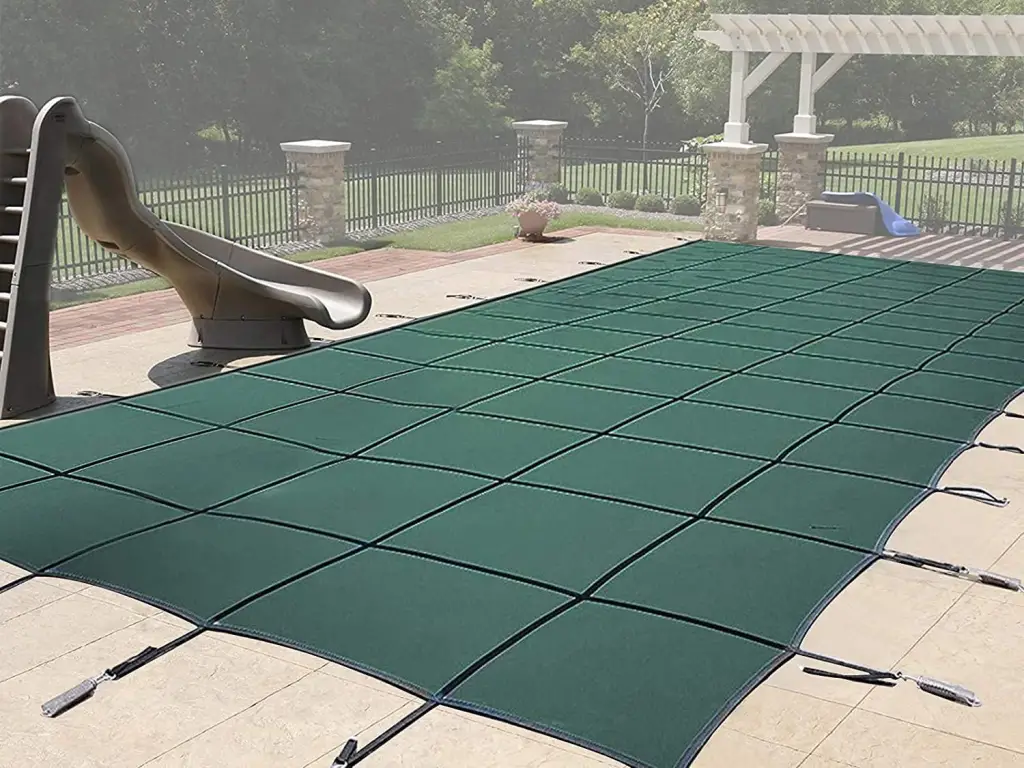
Using a pool cover when your pool is not in use can help reduce heat absorption and evaporation. Covers can be solid or mesh, and some are even designed with reflective or insulating properties to further enhance cooling.
Pros:
- Helps maintain a more consistent water temperature
- Reduces evaporation and water loss, saving on refills and chemical treatments
- Can keep debris and contaminants out of the pool, reducing cleaning needs
- Provides a safety barrier to prevent accidental falls or drownings
Cons:
- Requires manual labor to apply and remove the cover
- May not be practical for frequent pool use or entertaining
- Can be cumbersome to store when not in use
- May not provide significant cooling in extremely hot conditions
Maximizing Your Pool Cooling Efforts
To get the most out of your pool cooling strategies, consider these additional tips and best practices:
1. Monitor Water Chemistry
Regularly testing and adjusting your pool water chemistry can help ensure optimal conditions for cooling and comfort. Proper pH, chlorine, and alkalinity levels can prevent algae growth and keep the water clear and inviting.
2. Circulate the Water
Running your pool pump and ensuring proper water circulation can help distribute cooled water throughout the pool and prevent stagnation. Consider running your pump during the cooler hours of the day, such as early morning or late evening, to maximize cooling efficiency.
3. Utilize Pool Timers
Installing a pool timer can help automate your cooling efforts and ensure that your systems are running at optimal times[1]. For example, you can set your pump to run during off-peak hours or your chiller to kick on when the water temperature reaches a certain threshold.
4. Combine Cooling Methods
Using a combination of cooling techniques can provide a more comprehensive and effective solution. For example, pairing a shade structure with a pool chiller or incorporating water features with strategic landscaping can help maximize your cooling efforts and create a more comfortable swimming environment.
Conclusion
Keeping your pool cool and refreshing during the hot summer months is essential for maximizing your enjoyment and making the most of your backyard oasis. By implementing a combination of shade solutions, cooling systems, and natural techniques, you can effectively regulate your pool water temperature and create a comfortable swimming environment for you and your loved ones.
Remember to consider factors such as your climate, pool size and depth, sun exposure, and personal preferences when choosing the best cooling strategies for your needs. Don’t be afraid to experiment with different methods and combinations until you find the perfect balance for your backyard retreat.
With a little planning and investment in the right tools and techniques, you can beat the heat and keep your pool cool and inviting all summer long. So dive in, cool off, and enjoy the ultimate backyard swimming experience!

